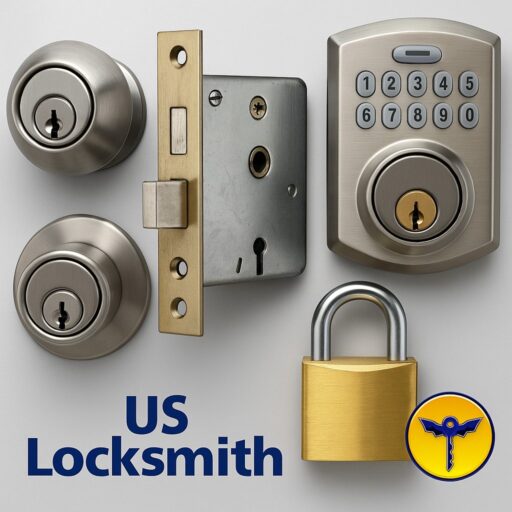Choosing the right type of lock isn’t just about function — it’s also about prevention. Certain high-security locks act as visual deterrents, signaling to would-be intruders that a property is professionally secured and not worth the risk. Whether it’s a reinforced mortise lock or a smart system with keyless entry, visible security measures alone can significantly reduce break-in attempts.
That’s why it’s important that both business owners and property managers from Kendall to Deerfield and across South Florida understand the most common commercial lock types, their strengths, and where they’re best used. This guide breaks down the essential lock types for modern commercial security in Florida and the world.
1. Mortise Locks
Overview: Mortise locks are embedded into the door itself, offering a robust locking mechanism that combines a latch and a deadbolt.
Strengths:
- High durability and resistance to forced entry.
- Suitable for high-traffic areas due to their longevity.
Applications:
- Commercial buildings, hotels, and institutional facilities.
2. Deadbolt Locks
Overview: Deadbolts provide a solid metal bolt that extends into the door frame, offering enhanced security.
Strengths:
- Effective against forced entry techniques.
- Available in single and double-cylinder variants.
Applications:
- Exterior doors of commercial and residential properties.
3. Cylindrical Lever Locks
Overview: Commonly used in commercial settings, these locks feature a lever handle and are easier to operate than knob locks.
Strengths:
- ADA compliant and user-friendly.
- Available in various functions, including entry, privacy, and passage.
Applications:
- Office interiors, classrooms, and restrooms.
4. Electronic and Smart Locks
Overview: These locks utilize electronic mechanisms, allowing for keyless entry through codes, cards, or biometric data.
Strengths:
- Enhanced access control and audit trails.
- Integration with security systems and remote management.
Applications:
- Businesses, universities, and research facilities requiring controlled access and monitoring.
5. Padlocks
Overview: Portable locks that can secure gates, storage units, and equipment.
Strengths:
- Versatility and ease of use.
- Available in various sizes and security levels.
Applications:
- Securing outdoor assets, lockers, and temporary setups. Can always be added onto already existing lock mechanisms as an additional safety measure.
6. Cam Locks
Overview: Compact locks commonly used in cabinets and drawers.
Strengths:
- Simple mechanism and installation.
- Cost-effective for securing enclosures.
Applications:
- File cabinets, mailboxes, and display cases.
7. Lever Tumbler Locks
Overview: Utilize a set of levers to prevent the bolt from moving without the correct key.
Strengths:
- High resistance to picking.
- Durable and reliable for specific applications.
Applications:
- Safes, strongrooms, and certain institutional settings.Wikipedia
8. High-Security Locks
Overview: Designed with advanced features to resist manipulation and unauthorized access.
Strengths:
- Patented key control systems.
- Resistance to drilling, picking, and bumping.
Applications:
- Facilities requiring stringent security measures.
9. UL 437 Rated Locks
Overview:
UL 437 is a security rating awarded to locks that meet rigorous standards for resistance to picking, drilling, and physical force. These locks are often used in high-security environments where compliance with industry benchmarks is critical.
Strengths:
- Tested for resistance to picking, bumping, and physical attacks
- Meets strict UL (Underwriters Laboratories) certification standards
- Often includes hardened inserts and advanced cylinder design
Applications:
- Government buildings, financial institutions, and data centers
- Any commercial property requiring verified high-security hardware
10. Padlocks with Boron Alloy Shackles
Overview:
A step up from standard padlocks, models featuring boron alloy shackles provide enhanced resistance against bolt cutters and sawing tools — common break-in methods in commercial and outdoor scenarios.
Strengths:
- Extreme cut resistance compared to standard hardened steel
- Suitable for securing high-value outdoor equipment
- Weather-resistant for long-term use
Applications:
- Warehouses, industrial facilities, storage containers, and trailers
- Commercial fencing, gates, and loading docks
11. Biometric Locks
Overview:
Biometric locks use fingerprints or retinal scans for keyless, high-security access. They’re growing in popularity among businesses and institutions that require restricted access with detailed entry logs.
Strengths:
- Cannot be picked or bumped using traditional methods
- No physical keys to lose, copy, or steal
- Access can be granted or revoked digitally
Applications:
- Server rooms, medical facilities, restricted labs, and executive offices
- Residential smart security systems with high-tech integration
The Role of Commercial Locksmiths
Choosing the right lock is only half the equation. A qualified commercial locksmith ensures the lock is installed to spec, functions properly, and aligns with your security objectives. Professional locksmiths can assess your property’s layout, traffic patterns, and threat level to recommend the most appropriate lock types — whether it’s a UL-rated deadbolt, an electronic smart lock, or a restricted keyway system.
They also handle maintenance, system upgrades, and rekeying when staff changes occur — all essential services for maintaining security over time. In short, working with a knowledgeable locksmith helps turn your security plan from theoretical to practical.
Conclusion
Understanding the various types of commercial locks and their specific applications is essential for selecting the right security solution. Factors such as the level of security required, ease of use, and compliance with regulations should guide the decision-making process. Consulting with Professional Locksmith can provide further insights tailored to specific needs.
Secure Your Property with Trusted Hardware
Not sure which lock is right for your home or business? Should you combin more than one type? Is a single strong lock enough? Our team at Professional Locksmith has experience installing and servicing the several different types of locks mentioned above. We work across South Florida from Deerfield, Kendall, to Boynton to ensure residents and business owners have the tools they need to stay secure.
Call us today or contact us for expert advice and installation
Want to know which *brand* of lock is best for you?
Want to know how to choose the right lock?
Want to know more about us? Still have some questions?
Check out our many other pages for your locksmithing needs.

